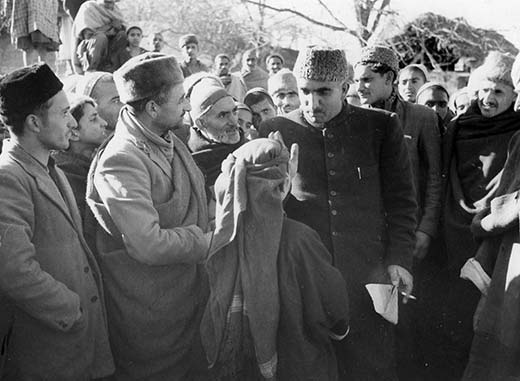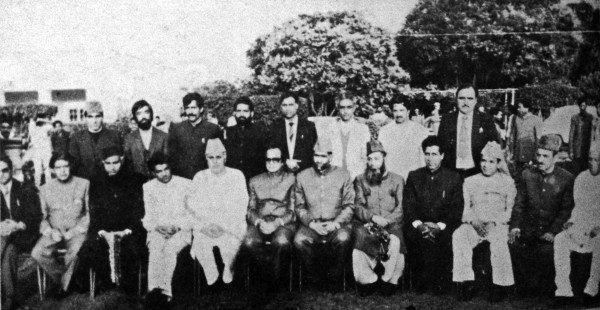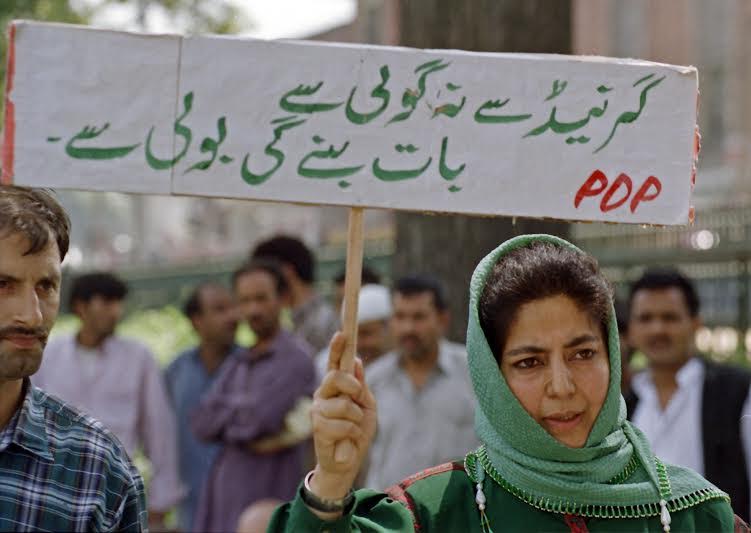Kashmir Life desk offers snapshots of the assembly elections that J&K witnessed post-partition

(Ladies took lead in some areas in the voting process amid boycott call by separatist leadership in recent elections. (KL Image: Shah Hilal)
Unlike mainland India, world’s largest democracy has one peculiar thing making it distinct in Kashmir: democracy here ends, instead of starting, with elections. While in rest of plains, it is emerging stronger, it is getting fragile, weaker in J&K to the extent that even a panch, who lacks any legislative authority and is part of the developmental narrative, needs to take oath of allegiance to uphold India’s integrity.
The evolution of the process of elections in Kashmir is itself an interesting story. Every election in Kashmir is distinct and dissimilar with other exercises.
October 1951
Sheikh Mohammed Abdullah, the then Emergency Administrator, termed October 31, 1951, the day of polling, as “the day of the destiny”. The process envisaged creating voter-list, delimiting berths and many other things and it took almost a year. Kashmir was given 43 seats, Jammu 32 and 25 were reserved for PaK. But interestingly NC didn’t permit anybody to contest. It used the ‘peace brigade’ and ‘volunteers’ to break their opponents’ legs, literally.
History has recorded Mirza Abdur Rashid receiving 14 stitches, Mufti Abdul Gani surviving with a fractured leg and their colleagues Mohammed Hussain Khan, Nooruddin Ganai getting hospitalised. Opponents nominations were rejected at 41 seats in Kashmir but the Returning Officers failed to reject the papers of two opponents – Shiv Narain Fotedar (Srinagar) and Giani Sant Singh (Baramulla), contesting against NC’s Shyam Lal Saraf and Harbans Singh, respectively. Situation forced Fotedar jump out of the fray as Singh surrendered on the day of polling. All the 43 Kashmir seats were won by NC unopposed.
Same situation forced Praja Parishad, Jammu’s main opposition, to boycott the polls, helping NC to have entire house of its own. This house drafted the J&K constitution!
March 1957
Situation had changed. Sheikh Abdullah was in jail as Bakhshi Gulam Mohammed was ruling the roost as head of a hijacked NC. He won 68 of 75 seats in three day polls between March 5 and March 7. These included 43 seats (six from Jammu and 37 from Kashmir and Ladakh) he got uncontested. He left only Khanyar to an independent – Abdur Rehman Bhat. From Jammu, five seats went to Praja Parishad and one to Harijan Mandal and another to an independent. History has recorded Bakhshi unleashing an upgraded ‘peace brigade’ on his opponents to dominate J&K’s first legislative assembly.
February 1962

(Bakshsi Ghulam Mohammad taking to a lady in Kokernag area in 1954 in this file pic.)
By now autonomy was fairly reduced as Election Commission of India has replaced State Election and Franchise Commission. But that made no difference. Of 44 seats in Kashmir and Ladakh, NC left just one for an independent candidate – Abdul Gani Mir (Handwara), getting 33 unopposed and rest with marginal contest. From Jammu, it took all except four seats. It was in this context that Pandit Nehru had famously told Bakhshi: “It would strengthen your position much more if you let a few seats to bona fide opponents”. In October 1963, Bakhshi resigned paving way for his puppet Shamsuddin Kath to takeover. In December 1963, Delhi was managing one of serious crisis in history when the holy relic disappeared from Hazratbal shrine.
March 1967
By now Bakhshi was ‘ousted’ as Gulam Mohammed Sadiq was holding the throne. He had replaced Kath in February 1964, and 11 months later he formally founded Congress in the state on January 26, 1965.
In the first week of March 1967, there were 415 nominations from across the state for the elections of which Returning Officers rejected 118 papers from Kashmir enabling 22 ruling party candidates winning unopposed. In an election participated by 59 percent voters, Congress secured 61 seats followed by Bakhshi led NC (Bakshi) with eight seats as Bahratiya Jan Sangh and independents had three members each.
February 8, 1972
Sadiq died in December 1971 within days after the Indo-Pak war over Bangladesh and was replaced by Syed Mir Qasim. Plebiscite Front stated that Kashmir requires a solution within Indian constitution. In this situation when elections were held on February 8, only 341 contestants were left in the fray for 75 seats as nomination papers of 60 were rejected. Many others withdrew their nominations. Five seats including that of Syed Mir Qasim (Verinag), who retained the berth of Chief Minister, went to Congress uncontested. Congress that was being termed the “gutter worms”, and “socially boycotted” won 58 seats as NC boycotted. Jamat-e-Islami that contested for the first time got five, Bharatiya Jana Sangh three seats as nine went to the independents. Abdul Gani Lone and Syed Ali Geelani made their maiden entry to the state assembly. After Indira Abdullah accord in 1975, Mir Qasim stepped down and paved way for Sheikh Abdullah as Chief Minister on February 25, 1975. However, Congress pulled out the support and the government collapsed on March 16, 1977.
July 3, 1977
Within days after the elections were announced for the state, Chief Minister Sheikh Mohammed Abdullah suffered a heart-attack that created a sympathy wave and negated to a larger extent the ill will, which the Indira-Abdullah accord of 1975, had created.
Awami Action Committee led by Mirwaiz Moulana Mohammed Farooq, Abdul Gani Lone and Moulana Mohammed Sayed Masoodi allied with Janta Party and even Prime Minister Morarji Desai visited Mirwaiz Manzil in the old city. Congress and ruling NC were participating separately but the former did not field candidates against Sheikh Mohammed Abdullah and Mirza Afzal Beig. Similarly Janta alliance did not field any candidate against Jamat-e-Islami’s Syed Ali Geelani.
Around 67.70 percent of electorate participated to elect 76 from 409 candidates in fray. NC won 47, Congress 11, Janta Party 14, Jamat-e-Islami one as three went to independent contestants.
Though this election is termed to be first fair exercise, historian Prem Nath Bazaz who himself contested believes otherwise. He authored Democracy Through Intimidation And Terror to blast this theory. NC, he recorded, forced a section of the population to migrate to safer places. KMDA, which for the first time deviated from NC, became the target as 123 of its vehicles were damaged. AAC, part of the Janta alliance, accused NC of hooliganism, he said.
In the subsequent days, three parties were formed: Islami Jamiat-e-Talaba, Peoples’ Conference and Panthers Party. On September 8, 1982, Sheikh passed away and was replaced by Dr Farooq Abdullah.
June 6, 1983
One of the best participated elections, 73.24 percent electors cast their votes. This election had a massive support for Dr Farooq Abdullah. Mostly, it was a sympathy vote. In the 76-seat house, NC got 48, Congress 26, Abdul Gani Lone’s PC got one while two others went to independents. Within eight months, Dr Abdullah signed death warrant paving way for hanging of Maqbool Bhat on February 11, 1984.
Soon, Dr Farooq grew unpopular as he increasingly allied with Indira’s opposition. Congress finally triggered a split leading his brother-in-law Ghulam Mohammad Shah to topple his popular government on July 2, 1984. Congress triggered communal disturbances in February 1986 that led to dismissal of Shah’s government. By then, Rajiv Gandhi had succeeded his assassinated mother. Then Rajiv-Farooq accord had taken place and it was endorsed and supported by AAC that had the alliance with NC since 1983’s ‘double-Farooq accord’. By November 1986, Dr Abdullah was back as Congress supported Chief Minister.
March 23, 1987

(Post March 23, 1987 elections, Dr Farooq with his cabinet after taking oath of office and secrecy. (Photos in special arrangement with MERAJUDDIN))
For the first time, the Congress-NC alliance was challenged by a 13-party alliance the Muslim United Front (MUF).
Though nobody anticipated MUF making government, NC-Congress combine used all its might and rigged the polls on March 23, 1987. MUF candidates won but announcements were made in favour of the ruling party candidates. Almost all the MUF leaders and activists were arrested. People were so involved that 74.42% of electors voted to choose 76 from 518 in fray. Participation in Kashmir crossed 80 percent.
But MUF could only get four seats, NC got 40, Congress 26 while 4 others went to independents and two to BJP. Three of the 4 MUF MLAs resigned from the assembly in late 1989 when the militancy erupted.
Within a year after 1987 elections, militancy erupted in Kashmir that erased the entire fabric of traditional politics. After a trail of destruction and mayhem, Dr Abdullah government resigned on January 19, 1990 apparently in protest against the appointment of Jagmohan as governor, allegedly by the then Home Minister Mufti Mohammad Sayeed.
September 1996
For nearly seven years Delhi remotely controlled Kashmir through its governors. Many years later, Delhi decided to conduct polls and transfer power to a locally elected government. NC the main political party of the region was against the idea of polls as they were facing serious problems in reconnecting with the people. Delhi held Lok Sabha polls in May 1996 as NC boycotted. But it pressurized NC thinking their absence will create a new political structure that influential security grid can manage so easily.
During the multi-phase polls in September 1996, the unwilling people were literally dragged out of their homes by the security grid to the polling booths. Participation in polls crossed 53%. Eventually NC emerged with a historic high number of seats in the assembly – 57 in an 87-member house, BJP got eight, Congress seven, Janta Dal bagged five, BSP four, and the rest were secured by independents and other small parties.
Dr Farooq Abdullah-led government was just the change at the top level as ground situation remained same. It rebuilt militancy-devastated Kashmir but failed to address the human rights situation or bring in some reform. It, however, submitted a resolution to Delhi seeking restoration of greater autonomy that BJP-led NDA government rejected. By 1999, some of the Congress members resigned and PDP was constituted. It played an effective opposition in the subsequent days.
Autumn 2002

(CM Mehbooba Mufti (KL Image: Fayaz Kabli).)
With Vajpayee in power, the elections were held with less intimidation and slightly improved fairness. In six years, the ruthless counter-insurgency had accumulated a huge load of unpopularity for NC and it faced anti-incumbency. With 45 percent turnout in the multi-phase elections held in September and October, the results led NC to emerge as the single largest party with 28 seats as its losses led PDP to bag 16 berths. Congress got 20 seats, Panthers Party had four seats as 13 independents were elected. With nobody from influential Abdullahs making to the assembly, Mufti Mohammad Sayeed successfully convinced the Congress that the verdict is against the NC. This eventually led to the PDP-Congress alliance that ruled J&K in turns till Ghulam Nabi Azad’s government fell at the peak of 2008 land row after PDP pulled the support.
November 2008
Shocking observers with a 60.5 percent turnout within months after the land row was over, the results were interesting. NC retained its 28 seats and PDP improved to 21. Congress got 17 berths and BJP, apparently capitalizing on Amarnath land row got 11 seats. The remaining seats in 87-member house went to independents and small parties. While the old guard in Congress was supportive of re-stitching the earlier alliance with PDP, two things played against it – the friendship between Omar Abdullah, who won from Ganderbal, and Rahul Gandhi and, PDP’s withdrawal of support to Azad earlier that year. PDP was pushed to the opposition benches.
Omar’s six year regime witnessed three major crises – the double murder in Shopian in 2009 that impacted part of summer across Kashmir, 2010 unrest in which more than 120 youth were killed and at the fag end of his rule, the devastating floods.
2014
A strong anti-incumbency helped opposition PDP to drum up support for a regime change. It played the second card of resisting the BJP that had emerged as a major force under Narendra Modi in plains. The fear of BJP trying to make serious inroads in Kashmir triggered a chain reaction that led to a participation of 65 percent. But it did not get PDP what it hoped. PDP got only 28 seats, BJP got 25 seats, for the first time in history, NC and Congress reduced to still-respectable 15 and 12 berths, respectively. Peoples Conference got two seats and the balance berths went to independents. In the hung house, PDP and BJP joined hands to form the government after they took almost two months in negotiating a deal, the Agenda of Alliance. With disruptions after Mufti’s death in January 2016, Ms Mehbooba Mufti replaced her father after being assured that the CMP would be implemented.















